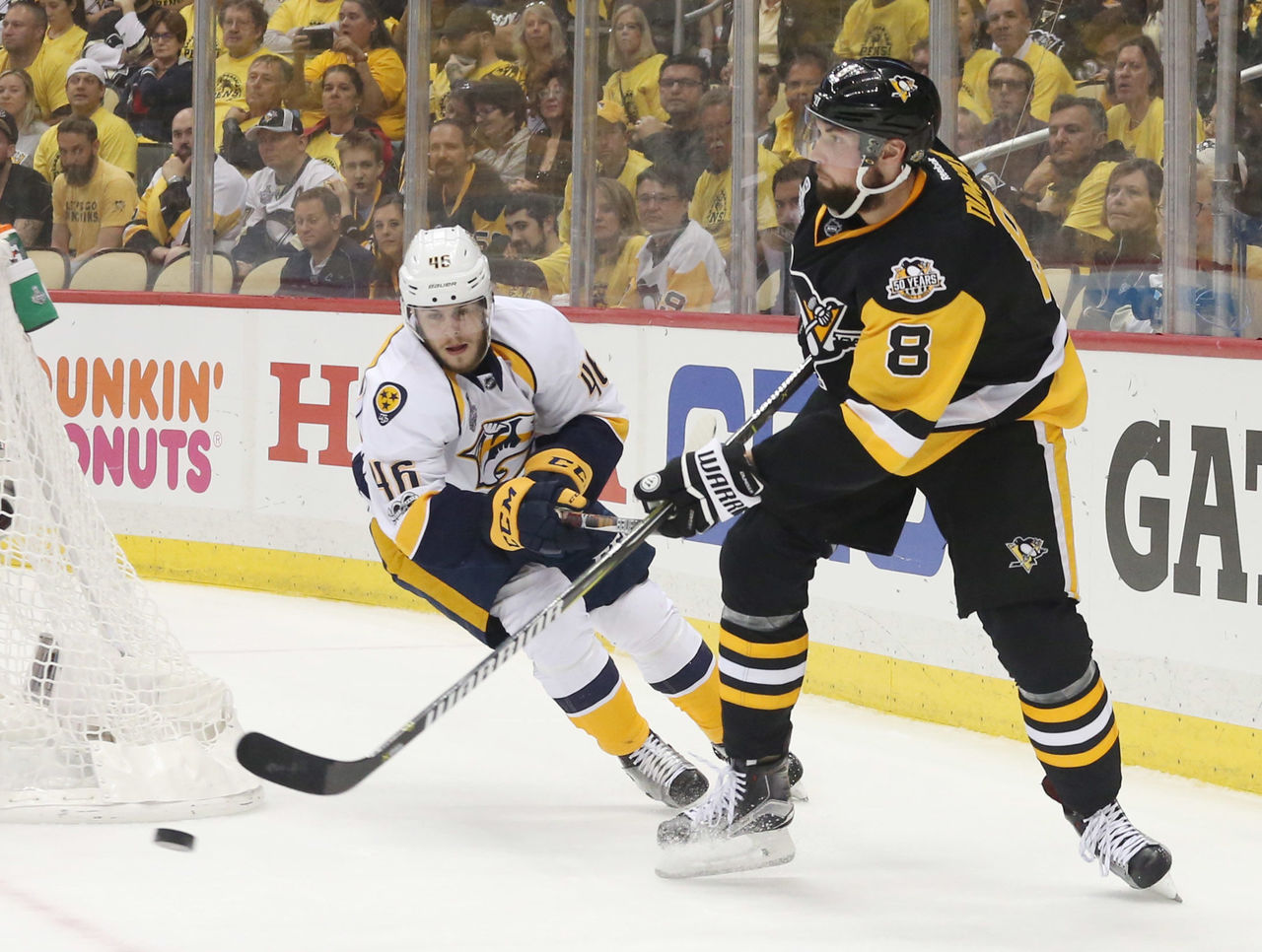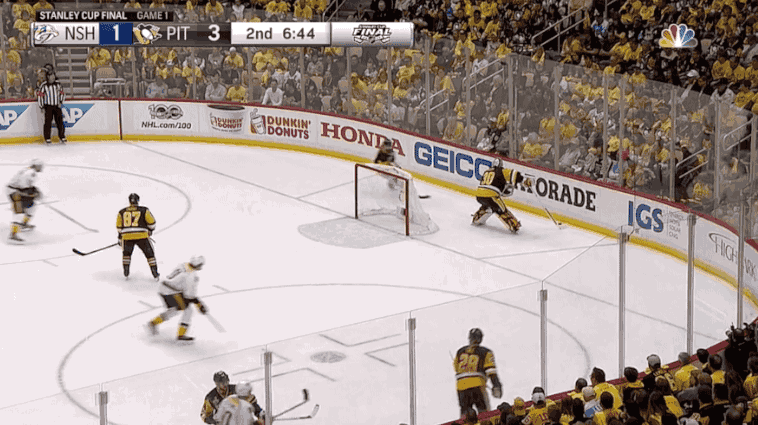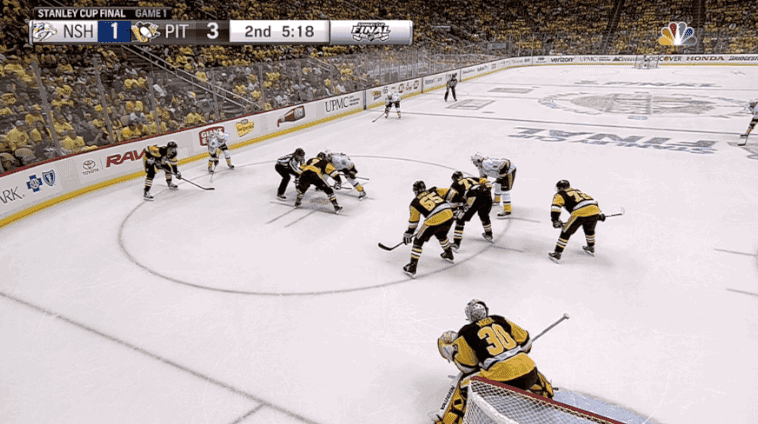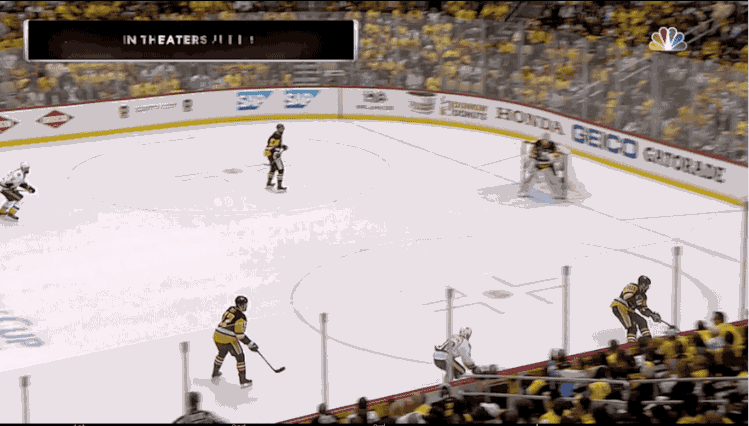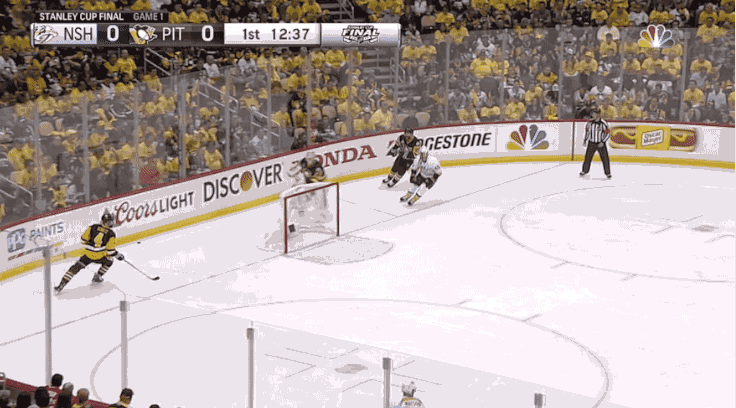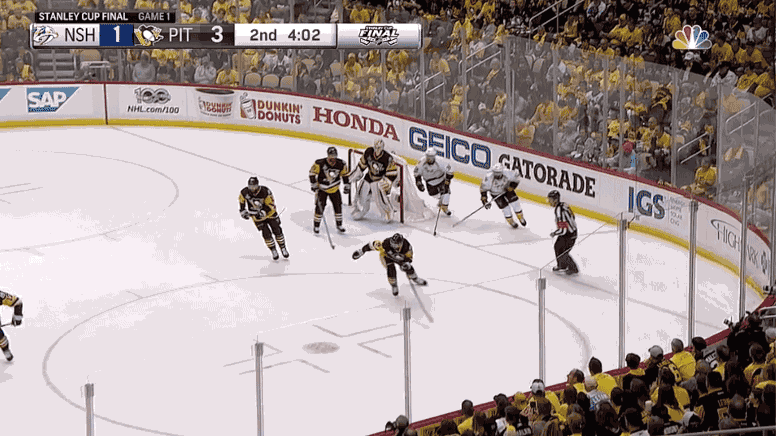Just about everything from the Penguins victory over the Nashville Predators in game one of the Stanley Cup final was ugly, except for the result.
As you’ve probably heard by this point, the Penguins went in excess of a half hour without generating a single shot on goal. They didn’t have much to discuss in the attempts department, either.
Despite their inability to muster any type of offense for just over half of the duration of the entire game, they actually defended pretty well. Nashville ended the night with only 21 shots at even-strength, and only 36 even-strength shot-attempts through the course of the night. For a frame of reference, the oft-maligned offense of the Penguins managed 26 even-strength attempts on their own, despite mustering only seven in the second period.
But playing good defense is a multi-faceted responsibility. It just isn’t about keeping a great gap, blocking shots, and separating forward from puck.
Part of playing good defense is taking care of the puck, making smart outlet passes, starting the offensive breakout in a responsible fashion.
In that regard, game one was an unmitigated disaster from a Penguins perspective.
In fact, a large part of the Penguins inability to generate offense for a 30+ minute stretch of the game starts with what was happening way back in their own defensive zone as they attempted to to start their offensive sequences.
The Predators expected the Penguins to head to the wall for support in their breakout attempts. It’s been the primary area of success throughout the Mike Sullivan era. The Penguins, as we’ve often discussed on this site, use the wall as a 4th forward. Their bread and butter is heading up ice with puck support, shielding defending players off by protecting the puck along the wall. They use chip plays off the boards to methodically work their way up ice. In game one, the Predators were waiting for them along the wall, and the Penguins could not find another answer.
The Penguins key to generating offense on a more consistent basis starts right here. If they can fix their breakout, they’ll inherently find themselves in better positions to get pucks on net. Let’s take a look at some clips.
The Predators recipe is twofold. Put pressure on the puck carrier, then take his options for an easy zone exit away from him. When you’re a defenseman under duress, natural instinct says “I need to get rid of this puck as quickly as possible.” The easiest option is to bank it off the glass or make a “hope” play, where you toss the puck to an area and hope your teammate is the first one to it.
This example falls under the former. Justin Schultz has a chance to make a play on this puck. He’s got two forecheckers chasing him down. The Predators are aligned on the puck-side of the wall, waiting for this play to come their way. It does, and Colton Sissons hops on this chance and gets a great look at the net as a result.
This turnover comes courtesy of a defensive zone faceoff. Cullen wins the puck back, Brian Dumoulin jumps on it, and the Predators immediately chase after this puck with two forwards.
Now, this instance is particularly intriguing because you have two defensemen that can attempt to make a play here and both of them opt to go for the puck. Hainsey is on his forehand and would have a much better opportunity to make a play, but Dumoulin jumps on this puck on his backhand, putting him at an immediate disadvantage.
The backhander squirts along the wall. The Penguins have Patric Hornqvist making a beeline for this thing, but he’s got some unwelcome competition in the form of a pinching Predators defenseman.
Once again, this is the Penguins feeling the pressure of the Predators forecheck and just blindly making a “hope” play, banking on Hornqvist grabbing this puck uncontested. By this point in the game, it was all Nashville, and the consistent pressure of their forecheck has the Penguins confused on a faceoff win. I think this clip is a pretty good summation of the Penguins struggles in this game.
In the above clip, there isn’t a single Predators player located in the middle of the ice. All three forwards are posting up along the wall waiting for this puck to come to them.
Ian Cole, under duress once again, banks this puck off the wall on the backhand and it’s easily nabbed by a Predators forward.
Take a look at Bryan Rust in the middle of the ice. Not only does Cole have a clear cut lane to him, but there’s no one within 15 feet of him. He’s got a clean sheet of ice in front of him, with Nick Bonino in support at the top of the zone.
I could post 25 more instances of this type of behavior, but I think the point is made. In each of these sequences, the Penguins turned their puck-possession, an inherent chance at offense, into more work defensively. It’s not just about increasing the load on your team defensively speaking, although that’s a huge part of it. It’s also about not being able to create offense heading the other way. Remember what we said at the beginning, playing sound defense is just as much about what you do coming out of your zone as it is what you do when you’re trying to prevent shots and scoring chances.
Okay, so how do they fix it?
In the mess that was game one’s zone exits, there were some positives.
One way to avoid the Predators pressure is to reverse the flow of play on them. The Predators are going to attack the side of the ice the puck is located on. So if you can quickly switch the play from one side to the other, it’s going to take them a second to catch up.
This is something Justin Schultz has been particularly adept at. Let’s take a look at an example:
In this instance, Schultz can feel the pressure coming. There’s a Predator forward waiting for him to try and throw this puck up the wall on the near side. All of the Predators forwards are shifting to the strong side of the ice. So Schultz simply reverses the play away from them and gives the Penguins a much better chance at getting an opportunity to gain the zone with speed.
Another smart play here would’ve been to catch Nick Bonino at center ice with this pass. But the forecheck was too close to Schultz for him to be able to make such a risky pass without causing a turnover right in the front of his own net.
Reversing the play works just as well. You an see the Predators forechecker on the far side have to make a quick beeline for the far boards because Schultz changed the flow of play on him.
The biggest area of focus for game two and beyond is the middle of the ice. If the Predators are swarming the boards and taking away the boards, there’s going to be space in the middle. In the Ian Cole example above, I mentioned that Bryan Rust was wide open in the center of the the ice. In this instance, we see Schultz making a smart, skating play to avoid the wall and gain a zone entry using the center of the ice.
Schultz has no option in front of him because Bryan Rust is tied up with a Predators forward. Instead of making a blind bank off the boards, he picks his head up and makes the right play with the puck. He forces the forechecker to make a step to him, and then finds Nick Bonino in the middle of the ice.
The Penguins, without question, spent a good amount of time looking at video of game one specific to these zone entries. If they can beat the Predators up the middle of the ice on the breakout, the Predators are going to be a lot less inclined to be so aggressive on the forecheck.
Avoiding another shotless drought like the one they experienced in game one, starting in your own zone with clean exits is a great place to start. If the Penguins can clean that area of their game up, they’re going to see positive results and a serious tilt in play.
Add The Sports Daily to your Google News Feed!
